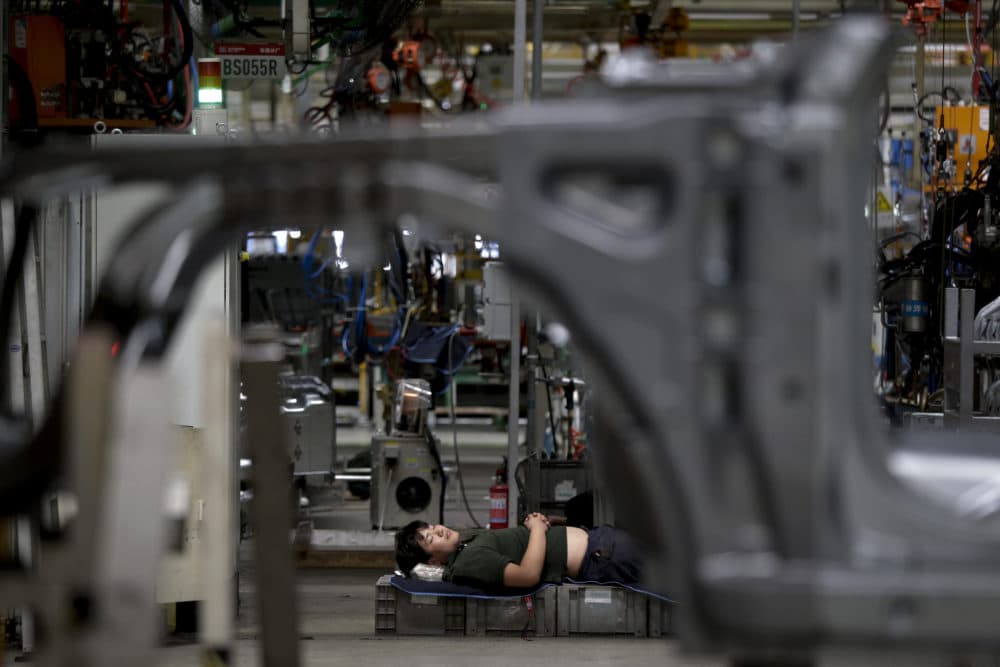Advertisement
With Sluggish Economy, Chinese Auto Industry Eyes U.S. Market
Resume
Willy Shih, professor of management at Harvard Business School, says the auto industry in China today looks like that of the U.S. in the 1910s or ‘20s: There are a significant number of companies in competition with each other, and some, like Chinese automakers Geely and BYD, “have global ambitions.”
“I went to the Shanghai Auto Show a couple years ago, and I think there were close to 300 vendors there,” Shih tells Here & Now’s Peter O’Dowd. “It's kind of [a] classic early market in China.”
However, with the excess in competition comes an excess in how many cars are being produced, and companies are struggling to sell all their inventory.
“A lot of the excess capacity has been driven by regional governments, who just say, 'We need to have a car factory in our locale,’ ” says Shih.
That, combined with a sluggish Chinese economy, is making domestic automakers turn to the United States, the richest auto market in the world, Shih notes.
“If you look at Chinese manufacturers, they've succeeded in all manner of goods export to the U.S.,” he says. “So, just like the Japanese before them and the Koreans after the Japanese, I think a lot of Chinese companies would say, 'If we're going to become a global player, we have to be in the U.S. market as well.' ”
Interview Highlights
On what Chinese automakers’ facilities look like
“They look like typical factories that you would see in the U.S. or in Europe or Japan or Korea. They are equipped with robots. One thing that struck me a couple of years ago when I went through one of these lesser-domestic brand factories in the city of Wuhan, which is in central China, was I looked at the factory as like, 'Wow. This is your typical car factory that is sized to make 230,000 vehicles a year or so. How come you're only making 30?' ”
On whether he thinks American consumers will find the cars being produced by Chinese companies desirable
“We will see some things that will appeal to American consumers, because they're innovative and they're kind of clever. I took a class to Shenzhen, and we went to the BYD factory. They are cranking the vehicles out.
“One of the problems in China is sometimes the parking spaces are kind of narrow, so when you buy a BYD car, there are some models that come with a remote control. What you do is, you get out of the car, and then you get a little remote, which is smaller than a TV remote, and you can start the car and you can steer it. So you can back it into the parking space and have no clearance on the side. I think there are American consumers who would look at that and say, 'That's pretty innovative. Maybe I'd like to try that.' ”
On the Chinese government’s push to produce more electric vehicles
“It's highly significant, because if you look at internal combustion engines and you look at people who really do these well — the Germans, the 'Big Three' in Detroit, the Japanese — they have generations of experience doing that. But the Chinese say, 'Well, if I can ride this technology transition, I'm already the number one producer of batteries. ... I don't need any of that infrastructure that all you guys are burdened with. We have a historic opportunity to just turn the competition upside down.' ”
On the trade war between China and the U.S. and its effects on the Chinese auto market
“We live in a world now that is very complicated, because the supply chains have been laid out over a relatively benign period, where we encouraged companies to locate in many different geographies and source parts from many different places, and it was efficient and it brought consumers low [costs]. And now what happens is you change the rules. I see a world going to companies saying, 'I have to serve the China market, and I have to serve the U.S. market.' Historically, I think the view was, 'I serve the markets from the most efficient sites. I'll use combinations of components sourced from lots of different areas.' I think that's changing, and there will be some big surprises in that.”
Jill Ryan produced this interview, and Kathleen McKenna edited it for broadcast. Jackson Cote adapted it for the web.
This segment aired on December 26, 2018.
